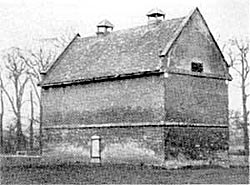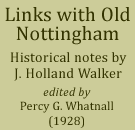< Previous | Contents | Next >
Clifton: the dovecote
 |
IN the middle ages the provision of food for man and beast during the winter was a serious problem. There was but a poor supply of hay and little corn could be spared to keep cattle alive.
The result was that about Michaelmas each year hundreds of head of livestock were slaughtered, and the survivors formed the nucleus for next year’s flocks and herds. The slaughtered carcases were roughly cleaned and dumped into great pits with a certain amount of salt to preserve them, and upon this half preserved, half putrid meat, our forefathers fed until spring brought back the growing grain, and animals could pasture freely once more.
This diet became monotonous at times, and it certainly must have been unhealthy, and so, in order to provide variety and a little fresh meat, pigeons were cultivated.
The value of the blue rock pigeon had been known to the Romans and perhaps long before Roman days. It was realised that the pigeon is exceedingly fertile, breeding nearly all the year round, and quickly maturing. Pigeon cotes, lined with nesting boxes, were set up throughout the country for the accommodation of these birds, and special steps were taken to protect them.
So pigeons became a very familiar sight in the land, and also on the table, and the mass production of pigeons only went out of fashion when in the 17th century turnips were introduced to England from Holland, and turnips proved so valuable a winter food that the horrors of the old slaughter-pits were done away with, and fresh butchers’ meat became available all the year round.
Then the need for pigeons gradually disappeared.
Clifton Dovecote seems to date from the eighteenth century, and is picturesquely situated on the village green. Its accommodation is enormous for it provides 2,300 nesting boxes.
This is by far the greatest number of nesting boxes in any dovecote in Nottinghamshire, and Clifton Dovecote is probably the most commodius in England.
